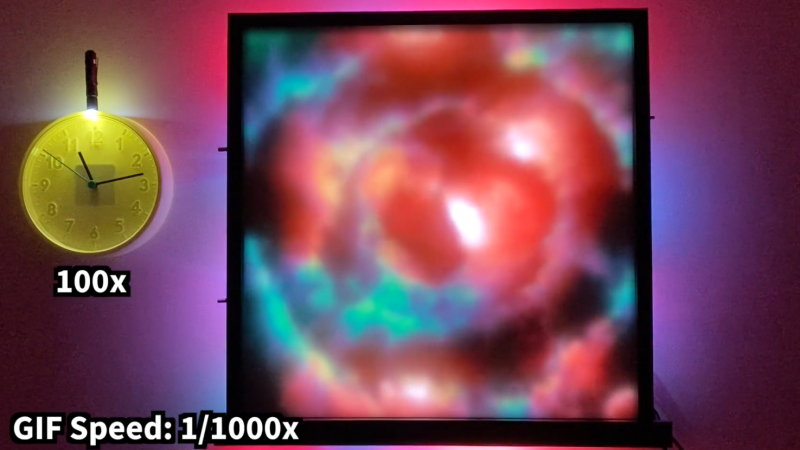Every bit of film or video you’ve ever seen is a mind trick, an optical illusion of continuous movement based on flashing 24 to 30 slightly different images into your eyes every second. The wetware between your ears can’t deal with all that information individually, so it convinces itself that you’re seeing smooth motion.
But what if you slow down time: dial things back to one frame every 100 seconds, or every 1,000? That’s the idea behind this slow-motion LED art display called, appropriately enough, “Continuum.” It’s the work of [Louis Beaudoin] and it was inspired by the original very-slow-motion movie player and the recent update we featured. But while those players featured e-paper displays for photorealistic images, “Continuum” takes a lower-resolution approach. The display is comprised of four nine HUB75 32×32 RGB LED displays, each with a 5-mm pitch. The resulting 96×96 pixel display fits nicely within an Ikea RIBBA picture frame.
The display is driven by a Teensy 4 and [Louis]’ custom-designed SmartLED Shield that plugs directly into the HUB75s. The rear of the frame is rimmed with APA102 LED strips for an Ambilight-style effect, and the front of the display has a frosted acrylic diffuser. It’s configured to show animated GIFs at anything from 1 frame per second its original framerate to 1,000 seconds per frame times slower, the latter resulting in an image that looks static unless you revisit it sometime later. [Louis] takes full advantage of the Teensy’s processing power to smoothly transition between each pair of frames, and the whole effect is quite wonderful. The video below captures it as best it can, but we imagine this is something best seen in person.















I think I figured out why some people (including myself) feel like they’ve been seeing articles twice within short timespans. This article is based on the hackaday.io project that was recently on the front page of hackaday.com in the “Featured Projects” section just below the list of articles. On my screen right now, both the featured project and the staff written review appear at the same time. Maybe this explains all the deja vu.
Even though you didn’t say you disapproved of this, I have to say I do approve.
It is much better to make an article about hackaday.io projects (even if it has come past in the “features articles” already), rather than creating “we must reach our quota” articles such as biographies of people.
I like the biographies, and I like the articles about hackaday.io projects.
I just like articles. If an article doesn’t interest me I just don’t read it, rather than writing comments complaining about it.
I’d like very much to know how you can obtain from four HUB75 32×32 RGB LED displays, a resulting 96×96 pixel display.
I have a HUB75 32×32 and want to multiply it.
Is it some kind of LED mitosis?
Huge disappointment, forget about panel multiplication. I had a look at the instructable and he is using 9 panels.
Too bad….
Good idea, I’ll try to incorporate matrix multiplication in my next project :-)
Good timing for this article as today – and every Wednesday – we have a LED Art focused chat session on Hackaday.io. It’s Wednesdays at 1PM Pacific Time, right after the weekly Hack Chat:
https://hackaday.io/messages/room/289684
If you’re working on your own LED Art, want to start, or just want to see some cool projects people are working on, come check it out!
Reminds me of ‘slow glass’ (Light of Other Days short story).